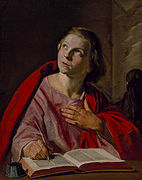
Frans Hals the Elder was a Dutch Golden Age painter, chiefly of individual and group portraits and of genre works, who lived and worked in Haarlem.

The Banquet of the Officers of the St George Militia Company in 1616 refers to the first of several large schutterstukken painted by the Dutch painter Frans Hals for the St. George civic guard of Haarlem, and today is considered one of the main attractions of the Frans Hals Museum there.

Pieter Biesboer, is a Dutch art historian and prolific writer on 17th-century Dutch art. His specialty is art from Haarlem.

Odesa Museum of Western and Eastern Art is a museum of Fine Arts on Pushkin street in Odesa, Ukraine.

Laughing Boy is a circular oil-on-panel painting by the Dutch artist Frans Hals. It belongs to the tronie genre and was painted around 1625. It is in the collection of the Mauritshuis.

Two Laughing Boys with a Mug of Beer is an oil-on-canvas painting by Frans Hals, created c. 1626, showing a Kannekijker (mug-looker). Someone looking into a mug refers to an old Dutch word for a glutton, greedy for more. This visual theme was also used to depict sight as one of the five senses, and various people have argued about whether this portrait was meant as one in a series of the five senses along with Two Boys singing for hearing and a variant version of The Smoker for smell:

Henricus Petrus Baard, was director of the Frans Hals Museum from 1946-1972.

Yonker Ramp and His Sweetheart is an oil-on-canvas painting by the Dutch Golden Age painter Frans Hals, painted in 1623 and now in the Metropolitan Museum of Art, New York City. The painting has also been titled as Young Man and Woman in an Inn or Portrait of Pieter Ramp.
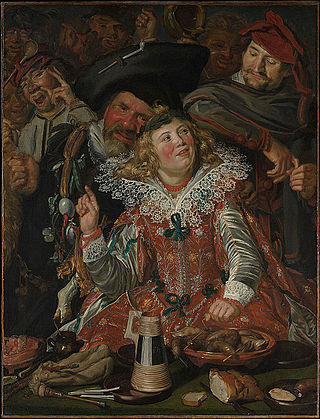
Shrovetide Revellers, also known as Merrymakers at Shrovetide, is a painting by the Dutch Golden Age painter Frans Hals, painted in around 1616–17. It is one of the earliest surviving works by Hals, and has been held by the Metropolitan Museum of Art, New York City since 1913. The painting shows people festivities at Shrovetide, an annual carnival of food and jollity which takes place before the Christian fasting season of Lent.

Claes Duyst van Voorhout is an oil-on-canvas portrait painting by the Dutch Golden Age painter Frans Hals, painted in 1638 and now in the Metropolitan Museum of Art, New York City.

Young Man with a Skull is an oil on canvas painting by the Dutch Golden Age painter Frans Hals, created in 1626-1628, now in the National Gallery, in London. The painting was previously thought to be a depiction of Shakespeare's Hamlet holding the skull of Yorick, but is now considered to be a vanitas, a reminder of the precarious nature of life and the inevitability of death.

Two singing boys with a lute and a music book is a painting by the Dutch Golden Age painter Frans Hals, painted c. 1625 and now in the Museum Schloss Wilhelmshöhe.

The Gypsy Girl, also known as Gypsy Girl, is an oil-on-wood painting by the Dutch Golden Age painter Frans Hals, painted in 1628-1630, and now in the Louvre Museum, in Paris. It is a tronie, a study of facial expression and unusual costume, rather than a commissioned portrait. The display of cleavage was not a common feature of costume seen in public in Hals' time and place.
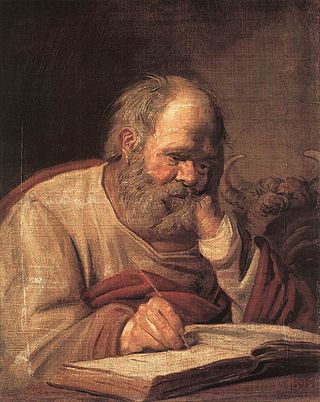
St. Luke is an oil-on-canvas painting by the Dutch Golden Age painter Frans Hals, painted in 1625 and now in the Odesa Museum of Western and Eastern Art.

St. Mark is an oil-on-canvas painting by the Dutch Golden Age painter Frans Hals, painted in 1625. It was purchased by Russian philanthropist Alisher Usmanov from the art dealer Colnaghi, London in September 2013 for the Pushkin Museum and donated by him to that museum in November that year, where it still hangs.

Portrait of Cornelia Claesdr. Vooght is a painting by the Dutch Golden Age painter Frans Hals, painted in 1631 and now in the Frans Hals Museum. The painting is an oil on panel and is considered a pendant portrait to that of her husband, the Haarlem brewer and mayor Nicolaes Woutersz van der Meer.
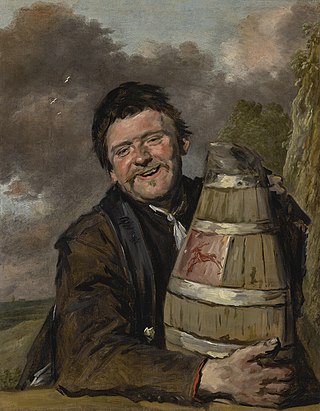
Man with a Beer Jug is an oil-on-canvas painting by the Dutch Golden Age painter Frans Hals, painted in the early 1630s, now in a private collection.

Portrait of a Man is an oil-on-canvas painting by the Dutch Golden Age painter Frans Hals, painted c. 1660 and now in the Frick Collection, New York City. The man has been mistakenly identified as Michiel de Ruyter.
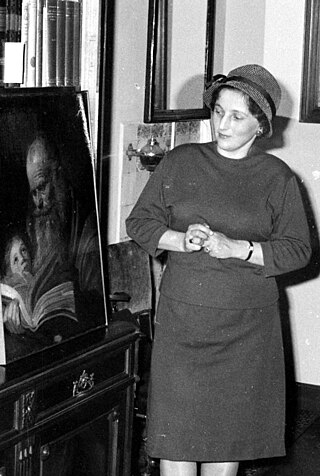
Irina Vladimirovna Linnik was a prominent Russian art historian. Considered an icon in Dutch art history and a leading specialist in Western European painting, Linnik's work was mainly concerned with the identification and attribution of 17th-century paintings from the Low Countries, France and Italy. Over the course of her career she identified, attributed and re-attributed around 250 different paintings.





